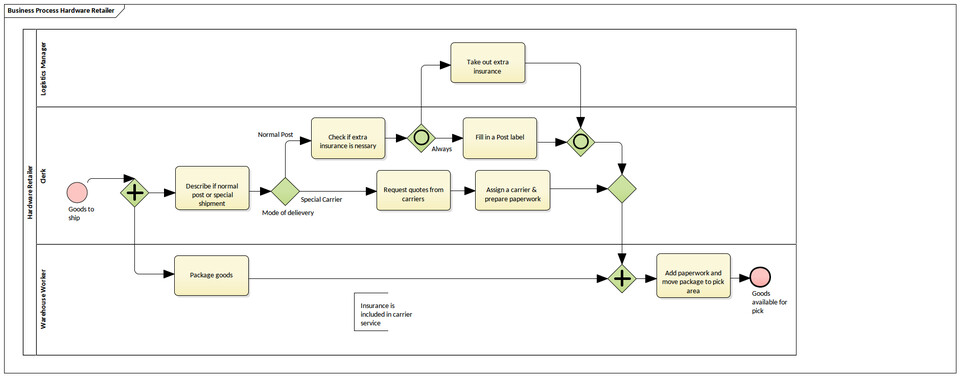|
|
Save |
||
|
|
Configure various properties of the current diagram |
||
|
|
Manage various aspects of the current diagrams behavior |
||
|
|
Undo changes made to this diagram (after last save) |
||
|
|
Open Project... |
||
|
|
New Project... |
||
|
|
Print... |
||
|
|
Output current diagram to printer |
||
|
|
Configure inheritance and implementation details for the current element |
||
|
|
Redo changes that have been Undone |
||
|
|
Start debugging the application configured in the current Analyzer script according to the debug settings |
||
|
|
Start the currently active application according to the analyzer debug script |
||
|
or
|
|||
|
|
Save the current diagram's image to the clipboard |
||
|
|
Find the source code associated with the currently selected element and open it for editing |
||
|
|
Generate code for a single element with options |
||
|
|
Generate and publish documentation in DOCX, PDF or Rich Text format |
||
|
|
Publish a document in DOCX, PDF or Rich Text format using built in or custom templates |
||
|
|
Create a document based on the content of the current Specification Manager package. Uses the Specification Manager List template by default |
||
|
|
Save the current diagram image to file or clipboard |
||
|
|
Save the current diagram's image to file |
||
|
|
Generate code for a single element with options |
||
|
|
Find the diagrams that use the current element |
||
|
|
Apply a model based Transformation to generate new model content based on the current selection |
||
|
|
Find the source code associated with the currently selected element and open it for editing |
||
|
|
Use the Specification View to edit package contents in a familiar document style manner |
||
|
|
View and manage a elements and diagrams I have locks applied to |
||
|
|
Paste element(s) into current diagram as new elements (copy of original) |
||
|
|
Use a birds eye view of the diagram to scroll and magnify |
||
|
|
Access and edit the templates used to create source code from the model |
||
|
|
Add content to the model from a pre-defined perspective based pattern |
||
|
|
Add new content to the model using a built-in pattern |
||
|
|
Add new content to the model using a built-in pattern based on perspective |
||
|
|
Show and hide specific relationships within the current diagram |
||
|
|
Close the currently active window |
||
|
|
Configure classifiers for various structural elements |
||
|
|
Import a complete directory tree in one pass. Language and other options can be configured |
||
|
|
Transform the current package using transformation template |
||
|
or
|
|||
|
|
Use transformation templates to build physical models from more abstract content |
||
|
|
Save the current package to its configured filename in XMI format |
||
|
|
Options to configure and run comma separated variable (CSV) based imports and exports |
||
|
|
Access the CSV import/export screen to run custom actions |
||
|
|
Access recent discussions in the model |
||
|
|
View and discuss the currently selected element |
||
|
|
Show the docked Change window for adding and managing changes associated with a model element |
||
|
|
When debug stepping, follow the execution point into method calls |
||
|
|
Use the Specification View to edit package contents in a familiar document style manner |
||
|
|
When debug stepping, automatically run to the end of the current context/method and return the the calling context |
||
|
|
Trace connectivity and dependencies between elements |
||
|
|
Execute the Test command configured in the current Analyzer script |
||
|
|
Add a new diagram to the current model |
||
|
|
Set the input focus to the currently active view |
||
|
|
Paste elements into current diagram as a reference ( link to original ) |
||
|
|
Load the current package from its configured filename (XMI import) |
||
|
|
Configure basic package control parameters such as output filename |
||
|
|
Set up version control settings for the currently selected package |
||
|
|
Apply a model based Transformation to generate new model content based on the current selection |
||
|
|
Find and select the current element in the Project Browser |
||
Advertisement |
|||
|
|
Validate Current Package |
||
|
|
Synchronize selected package with associated source code |
||
|
|
Preferences... |
||
|
|
Configure many options for appearance, behavior and default values |
||
|
|
Generate code for the currently selected item |
||
|
|
Run an extensive suite of integrity checks and optionally update model as required |
||
|
|
Run a spell check on the full model |
||
|
|
Publish a report in HTML (web) format for internal or internet based distribution |
||
|
|
HTML based report using static web pages. For local or internet based use |
||
|
|
Create a HTML based report based on the current Specification Manager package |
||
|
|
Work with package based scripts that defined multiple parameters required to build, test, run, debug, deploy and simulate applications based on model content |
||
|
|
Import a model from file based XML content |
||
|
|
Import model package(s) from a model interchange (XML) file. A variety of formats based on specifications from the OMG are supported |
||
|
|
Manage Analyzer scripts that define the build, run, test, deploy, simulate functions for the current package |
||
|
|
Add, edit and manage Analyzer scripts (build, run, test, deploy) and other Analyzer tools |
||
|
|
Reset selected elements to their original size then calculate best fit based on contents |
||
|
|
Create mapped relationships between element features (attributes, operations etc.) |
||
|
|
Use the Portals bar to access contextual actions |
||
|
or
|
|||
|
or
|
|||
|
or
|
|||
|
or
|
|||
|
or
|
|||
|
or
|
|||
|
or
|
|||
|
or
|
|||
|
or
|
|||
|
or
|
|||
|
|
Execute the Run command configured in the current Analyzer script |
||
|
|
Use the Portals bar to access contextual actions |
||
|
|
View, import and manage a variety of custom resources, templates and technologies |
||
|
|
Use Package Baselines to save, compare and restore different model versions |
||
|
|
Search the model for a particular element using specific criteria |
||
|
|
Manage and run searches within the current model |
||
|
or
|
|||
|
or
|
|||
|
or
|
|||
|
or
|
|||
|
or
|
|||
|
or
|
|||
|
or
|
|||
|
or
|
|||
|
or
|
|||
|
or
|
|||
|
or
|
|||
|
|
Create and edit the document permanently linked to the current element |
||
|
|
Export the current package as model interchange XML |
||
|
|
Export the current package to an XML based file for exchange between different models and different tools |
||
|
|
Open an XSD/XML file for display and editing in the code editor |
||
|
|
Open a document file in DOCX or Rich Text (RTF) format for viewing or editing |
||
|
|
Open, edit and manage source code for the current element or for ad hoc files within the local file system |
||
|
|
Open a source file in the current file system for editing |
||
|
|
Open the Learning Center |
||
|
or
|
|||
|
|
Edit internal code for Element |
||
|
or
|
|||
|
|
Use the Matrix to explore and edit relationships between sets of elements |
||
|
|
Edit and configure the templates used to perform Transformations |
||
|
|
Open the Analyzer Debug window to facilitate debugging and testing of the current application |
||
|
|
Open the main debugger window to start and control debugging and show debug output messages |
||
|
|
Access functions to start and control debugging of the current application |
||
|
|
Use the diagram toolbox to add new elements to the Specification Manage list |
||
|
|
Use the diagram toolbox to add new elements to diagrams |
||
|
|
Access a team based document repository of reviews, comments and templates |
||
|
|
When debug stepping, follow the execution point into method calls |
||
|
|
Open and view the XMI as exported for the current package |
||
|
|
Open the Schema Composer main editor for creating schema profiles |
||
|
|
Create and manage custom profiles for the generation of industry specific XSD files |
||
|
|
Generate code for all elements within the current context |
||
|
|
Add, edit and manage database models for a wide variety of target DBMS products |
||
|
|
Use a birds eye view of the diagram to scroll and magnify |
||
|
|
During debug stepping, execute but do not enter a method call. The execution point will move to the next source line in the current context |
||
|
|
Use the Portals bar to access contextual actions |
||
|
or
|
|||
|
or
|
|||
|
or
|
|||
|
or
|
|||
|
or
|
|||
|
or
|
|||
|
or
|
|||
|
or
|
|||
|
or
|
|||
|
or
|
|||
|
or
|
|||
|
|
Open the scripting window to access and manage model scripts |
||
|
|
Run a spell check on the current package only |
||
|
|
Use the spell checker to review the notes of all elements within the current package |
||
|
|
Put the currently selected docked window into Auto-Hide mode |
||
|
|
During debug stepping, execute but do not enter a method call. The execution point will move to the next source line in the current context |
||
|
|
Stop debugging the current application. The debugged application will terminate |
||
|
|
Generate a report of all diagrams in the current package (image only) |
||
Sparx Systems Enterprise Architect 16.1 keyboard shortcuts
Sparx Systems Enterprise Architect 16.1
This shortcut list is sorted by user, meaning that original structure (headings) is disregarded. You can see the original page here:
Sparx Systems Enterprise Architect 16.1 keyboard shortcuts.
Table of contents
Advertisement
Program information
Program name:

Web page: sparxsystems.com/products/ea
How easy to press shortcuts: 65%
More information >>Similar programs
Tools
Sparx Systems Enterprise Architect 16.1:Learn: Jump to a random shortcut
Hardest shortcut of Sparx Systems E...
OtherUser operations
Add Sparx Systems Enterprise Architect 16.1 to your list of favorites




What is your favorite Sparx Systems Enterprise Architect 16.1 hotkey? Do you have any useful tips for it? Let other users know below.
1111187
500126
412200
369199
309098
279494
21 hours ago
22 hours ago
22 hours ago Updated!
2 days ago
2 days ago
2 days ago Updated!
Latest articles